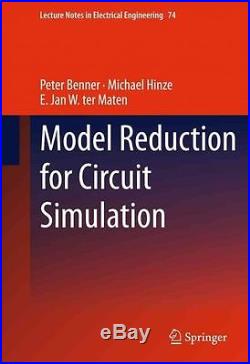

Model Reduction for Circuit Simulation. Simulation plays a major role in the computer-aided design of integrated circuits, yet its complexities in an age of miniaturization cause time-lags in product manufacture. Model Order Reduction resolves the dilemma, and this volume covers the latest results. Simulation plays a major role in computer aided design of integrated circuits (ICs). Mathematical models describe the dynamical processes and interactions of electrical devices. Verification of a circuit’s behaviour by means of solving these model equations in time and frequency domain is a mandatory task in the design process. The structures’ sizes are decreasing, the packing density gets higher and so do the driving frequencies. This requires to use refined models and take into account secondary, parasitic effects. The very high dimensional problems that emerge in this way may be solvable with the help of computer algebra in an unreasonable amount of time only. Clearly, this conflicts with the short time-to-market demands in industry. Model-Order-Reduction (MOR) presents a way out of this dilemma. Redundancies are resolved, less relevant quantities are replaced by the most significant ones. In this way, the problem’s complexity is reduced, keeping the main characteristics. Solving lower dimensional problems one can get statements on the circuit’s performance more quickly. With “Model Reduction for Circuit Simulation” we survey the state of the art in the challenging research field of model order reduction for ICs, and also address its future research directions. Special emphasis is taken on aspects stemming from miniaturizations to the nano scale. Contributions cover complexity reduction using e. Balanced truncation, Krylov-techniques or POD approaches. For semiconductor applications a focus is on generalizing current techniques to differential-algebraic equations, on including design parameters, on preserving stability, and on including nonlinearity by means of piecewise linearisations along solution trajectories (TPWL) and interpolation techniques for nonlinear parts. Furthermore the influence of interconnects and powergrids on the physical properties of the device is considered, and also top-down system design approaches in which detailed block descriptions are combined with behavioral models. MOR faces the same requests as those appearing with Response Surface Modeling (RSM) techniques for Robust Design, with emphasis on parameterization, parameter screening, and nonlinearity. Further topics consider MOR and the combination of approaches from optimization and statistics, and the inclusion of pde models with emphasis on MOR for the resulting Partial Differential Algebraic systems. X 6.5 in. Grand Eagle Retail is the ideal place for all your shopping needs! We are unable to deliver faster than stated. International deliveries will take 1-6 weeks. Please contact Customer Services and request “Return Authorisation” before you send your item back to us. We cannot take responsibility for items which are lost or damaged in transit. Home, Garden & Pets. Sign up to our newsletter to hear about new items and our latest offers. The item “NEW Model Reduction for Circuit Simulation by Hardcover Book (English) Free Ship” is in sale since Sunday, May 17, 2015. This item is in the category “Books\Nonfiction”. The seller is “grandeagleretail” and is located in Multiple. This item can be shipped worldwide.
- ISBN-10: 9400700881
- ISBN-13: 9789400700888
- Format: Trade Cloth
- Publication Year: 2011
- Language: English

NEW Model Reduction for Circuit Simulation by Hardcover Book (English) Free Ship
